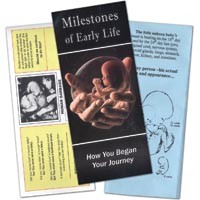In the debate over abortion, the city of Pittsburgh faces its own difficult choice: Which form of protection will abortion providers -- and their patients -- have to surrender?
Since the passage of a city ordinance in 2005, local abortion providers have been protected by two legal barriers: a 15-foot "buffer zone" surrounding clinic entrances, and an 8-foot-radius "bubble zone" that extends around any person within 100 feet of the door. An abortion-rights opponent, Mary Brown, filed a federal lawsuit alleging that the zones infringed on free-speech rights ... and on Oct. 30, a federal court ruled that the city could keep one zone or the other -- but not both.
"[U]se of both types of zones appears to be unprecedented among [ordinances] upheld by courts," wrote Anthony Scirica, the chief judge of the Third Circuit Court. Other aspects of Brown's case will be tried later, but for now, the city will have to surrender one of its zones.
Which one? That will likely be topic A at a Nov. 23 "status conference" scheduled before federal Judge Nora B. Fischer. Mayoral spokesperson Joanna Doven did not return calls for comment, but clinics "are unanimous that the 15-foot fixed zone is more important," says Susan Frietsche, who represents abortion providers as an attorney at the Women's Law Project.
The "buffer zone" has numerous advantages. "Without it, people could come right up to the doorway, and there'd be a bigger risk of altercations," says Becky McDermott, executive director of Allegheny Reproductive Health Center, in East Liberty. Plus, the zone is easy to police: A painted line marks the 15-foot radius around each clinic entrance, and while protesters walk right up to the line -- sometimes to pray, or to yell at patients or staff -- they generally don't cross it.
By contrast, "The bubble zone is hard to enforce," says Rebecca Cavenaugh, a spokesperson for Planned Parenthood of Western Pennsylvania. For one thing, it has to be "triggered" by a patient telling a protester to back off -- "and a lot of patients don't know about the law."
Anti-choice advocates have their own gripes about the "bubble zone."
"No one has an 8-foot measuring tape," says Ellie Bova, who handles outreach for Students for Life, a pro-life group based at Franciscan University in Steubenville, Ohio.
Scores of Franciscan students protest at Allegheny Reproductive Health every Saturday, when the facility provides abortions. The students are mostly non-confrontational, gathering in prayer circles and singing hymns.
More aggressive protesters sometimes do appear, and McDermott says police are called once or twice a month. But flashing graphic photos of dismembered fetuses "is not the pedagogy of Christ," says Father Dan Pattee, who chairs Franciscan's theology department and who also attends protests. While the students oppose abortion, "Why should we be flashing their sin up in their face? God doesn't deal with our sin that way."
Still, Pattee says, "sidewalk counselors would like the opportunity to get more literature in the hands" of patients. Students carry pamphlets that offer pro-life pregnancy counseling, while warning of "post-abortion complications" like "thoughts of suicide." Some pamphlets feature graphic photographs.
Other groups have messages of their own. Shari Lewis, who comes to East Liberty with a contingent from Westmoreland County, says women should know that "so many people would love to adopt." By having an abortion, she adds, "women are increasing their chance of breast cancer by 50 percent."
Abortion providers aren't anxious to make delivering that message easier, especially since it flies in the face of scientific consensus. The National Cancer Institute -- the government's principal cancer-research body -- conducted a 2003 symposium of breast-cancer researchers who declared, flatly, that "Induced abortion is not associated with an increase in breast cancer risk."
But dropping the bubble zone, Lewis and others say, would make it easier to get their message out. Also, Bova says, not having to argue over the 8-foot rule "would cut down on disagreements between us and escorts."
Or not.
If the bubble zone is removed, "I think people will get harassed more, chased down the street more," says Eli Kuti, who has provided security at abortion clinics for eight years.
Kuti acknowledges enforcement of the bubble zone is spotty, partly because police sometimes seem confused about the law. Demonstrators "sometimes corner people" heading into the clinic even now, she says.
But if patients are no longer shielded by a bubble-zone law, escorts may use their bodies instead: Some were practicing the tactic on a recent Saturday morning. That approach could increase the likelihood of physical confrontations with protesters.
The potential for bumping into escorts "has crossed my mind when we lose the bubble," says Katie Ginter, Students for Life President. Then again, respecting the bubble has already led her to bump into trees and trash cans "because sometimes there's no place else to go."
City Council President Doug Shields says that before the ordinance passed, "Police were frustrated because they didn't have guidance" about balancing free-speech with clinic access. Shields is staunchly pro-choice, but says, "This isn't about abortion: It's about maintaining public order."
But Shields says council is not in a "near-term rush" to pass new legislation. Abortion providers say they will see how the new legal situation plays out, documenting any complaints of trouble.
Until then, says Shields, "I'm not rolling the dice and going to the Supreme Court," given its current conservative majority. "We've got to wait for President Obama to get some new people in there."















